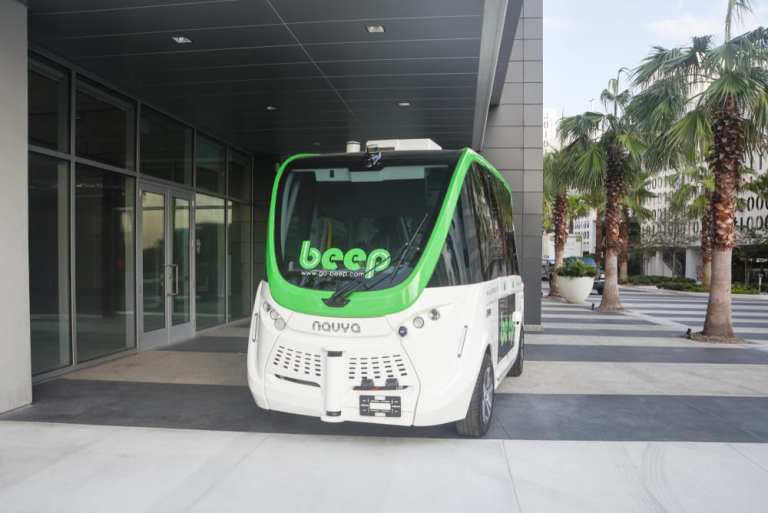
As consumers eschew car ownership, public transportation ridership has increased 21 percent over the past two decades. Recent efforts to upgrade transit systems with connected and autonomous vehicles could further drive this shift — but how can providers ensure the safety of vehicles? In the latest Intelligence of Things Tracker, PYMNTS talks with Joe Moye, CEO of passenger mobility service Beep, about the company’s autonomous transit pilot in Florida to find out.
Self-driving vehicles may not be as universally appealing as General Motors, Google and Tesla might think.
Public transportation ridership has increased 21 percent since 1997, and younger riders often view buses, trains and shuttles as eco-friendly ways to travel. Many consumers also have potential expense and safety qualms with self-driving cars, so automakers might find more millennials waiting at bus stops than shopping at Tesla dealerships.
Bringing reliable autonomous technology to public transportation could thus provide immediate benefits to American communities concerned about personal vehicles’ environmental impacts. Beep, an autonomous mobility solutions service, piloted a public, IoT-enabled self-driving shuttle earlier this year in the Florida suburb Lake Nona for that reason, said CEO Joe Moye.
Moye discussed the burgeoning world of autonomous vehicles, the environmental and economic benefits of self-driving public transport and the potential expansion of such services in a recent interview with PYMNTS. Beep’s shuttles can currently seat 10 passengers at a time and drive at a controlled speed limit of 16 miles per hour, Moye said, adding that this design reduces the number of vehicles on the road, lowers traffic jams and eliminates drivers’ parking frustrations.
“Autonomous vehicles are driving the next wave of disruption in transportation,” Moye said. “They’re providing safe, efficient and environmentally friendly transportation options for people of all ages. Because the shuttles are electric, they are eco-friendly, contributing to a greener environment in the Lake Nona area, as well. The electric autonomous vehicles further reinforce Beep’s commitment to improving the environment through reduced emissions.”
Autonomous Cars’ Safety, Security
Consumers have watched autonomous vehicles’ progress with great interest, but many have recently expressed concerns over these vehicles’ readiness. A new Tesla feature, the “Smart Summon” tool, raised eyebrows regarding public safety. It allows users to remotely command their cars to pull out of parking spaces via smartphone. Videos of near-misses and other kinks with the feature have already begun surfacing, and Tesla is not the only autonomous car maker facing such safety obstacles.
Beep has thus developed its shuttles with safety in mind, equipping them with enhanced cameras that allow the driverless software to optimally navigate. Every ride includes human attendants, a typical precaution for autonomous vehicle experiments, and Beep has also trained emergency personnel within Orange County to deal with the shuttle just in case human intervention is needed, Moye said.
“The autonomous shuttles are equipped with interior and exterior cameras and use effective guidance and detection systems while optimizing navigation and safety features,” he explained. “The Beep command center can communicate with the onboard shuttle attendant at any time.”
The company began its Lake Nona pilot as a free service for residents, with French electric car company Navya providing shuttles that work with Beep’s IoT-enabled software. Moye said that the technology may engage younger consumers, even though it targets residents who lack personal vehicle access or who may otherwise have driving difficulties.
“Specifically, we expect this to appeal to the millennial generation, the elderly and the disabled,” he stated. “The ease of access to community destinations will dramatically alleviate issues of traffic and parking congestion, which leads to fewer accidents and increased safety for all.”
Driving Autonomy Forward
Self-driving cars will continue to evolve as technology advances, and public transportation will remain attractive to innovators. Beep will look to broaden its pilot in the coming year, according to Moye.
“We are continuously looking for ways to improve user experience on the shuttles,” he said. “Beep will continue to introduce services to other planned communities like Lake Nona, along with other low-speed environments across the public sector, such as transportation hubs, medical and university campuses, entertainment venues, urban centers and more.”
Autonomous public transportation vehicles continue to share challenges with private self-driving cars. Hesitant consumers need to be assured of safety, and companies in this space must consider younger generations’ shifting transportation views that have been influenced by ridesharing services, such as Lyft and Uber. Players will need quick innovations if they wish to retain customer support and make autonomous vehicles fully roadworthy.